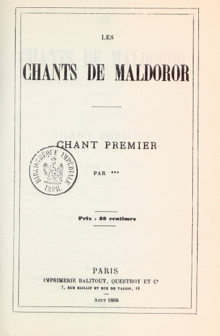Maldoror

Cover of the first French edition
|
|
| Author | Comte de Lautréamont (Isidore Lucien Ducasse) |
|---|---|
| Original title | Les Chants de Maldoror |
| Translator |
|
| Country | France |
| Language | French |
| Genre | Poetic novel |
| Publisher | Gustave Balitout, Questroy et Cie. (original) |
|
Publication date
|
1868–69 1874 (complete edition, with new cover) |
| Media type | |
| OCLC | 457272491 |
|
Original text
|
at French |
Les Chants de Maldoror (The Songs of Maldoror) is a poetic novel (or a long prose poem) consisting of six cantos. It was written and published between 1868 and 1869 by the Comte de Lautréamont, the pseudonym of the Uruguayan-born French writer Isidore-Lucien Ducasse. Many of the surrealists (Salvador Dalí, André Breton, Antonin Artaud, Marcel Duchamp, Man Ray, Max Ernst, etc.) during the early 20th century cited the novel as a major inspiration to their own works.
Les Chants de Maldoror is a poem of six cantos which are subdivided into 60 verses of different length (I/14, II/16, III/5, IV/8, V/7, VI/10). The verses were originally not numbered, but rather separated by lines. The final eight stanzas of the last canto form a small novel, and were marked with Roman numerals. Each canto closes with a line to indicate its end.
It is difficult to summarize the work because it does not have specific plot in the traditional sense, and the narrative style is non-linear and often surrealistic. The work concerns the misanthropic character of Maldoror, a figure of absolute evil who is opposed to God and humanity, and has renounced conventional morality and decency. The iconoclastic imagery and tone is typically violent and macabre, and ostensibly nihilistic. Much of the imagery was borrowed from the popular gothic literature of the period, in particular Lord Byron's Manfred, Charles Maturin's Melmoth the Wanderer and Goethe's Faust. Of these figures, the latter two are particularly significant in their description of a negative and Satanic antihero who is in hostile opposition to God. The last eight stanzas of the final canto are in a way a small novel dealing with the seduction and murder of a youth.
...
Wikipedia
